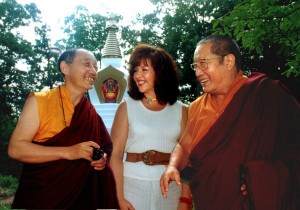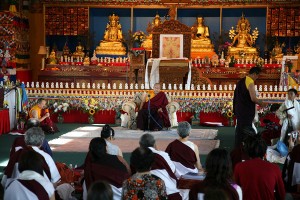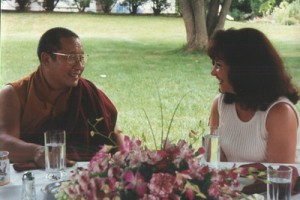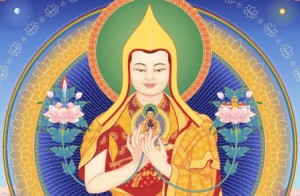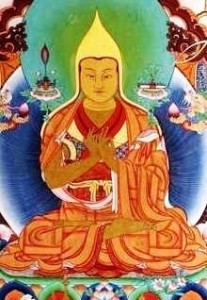The following is an excerpt from a teaching by Jetsunma Ahkon Lhamo called “Western Chod”
My teachers have instructed me that that practice is actually called ‘chöd’ (and there is an umlaut above the o). Actually there is no text to go with it so you couldn’t say it was the practice of chöd as it is written in the text. It has been called by my teachers the essence or essential nectar of chöd. So I have been given permission to continue to practice that way and also to teach others to practice in that way. My experience has been that it has made my life a lot easier.
Now how is that? Well, I’ll tell you. It came to pass that there were many sacrifices that needed to be made. I’m not saying this so that you’ll say “Oh, isn’t she a good girl!” Save it. I don’t care. But there were sacrifices that needed to be made. If I’d had my druthers, I would still be on a farm in North Carolina. By now I would not only know how to put up beans, but I would have the best darn garden you’d ever seen, and all the farmers around would be impressed. And I would have a dairy cow to boot. I would still be there. I would still be there, much isolated. I prefer a lot of privacy. Even though I seem to be good at this (I don’t know why but I seem to be good at this), I have to tell you that everyone who knows me well knows that to get me out of the house so that I’ll come and do my job, it takes oh, spraying with Pam and loosening her up with a crowbar. It’s not my natural tendency to want to come out and do this. I really don’t like this kind of thing.
Not only did privacy have to be given up (and that seems to be getting worse and worse), but also personal freedom. Now I am in the position where if I decide that I want to go somewhere and just not think about whether I look like a dharma teacher or not, just sort of be myself, I find that it’s a little tricky. It happens pretty often that people will come up to me and they will say “Are you that Buddha lady?” It really happens on a regular basis. In fact one time at the airport somebody came running up to me, “Are you that Jetsa Jetsa Buddha lady?” That Jetsa Jetsa Buddha lady, that’s me! So I have that kind of going on. And you know, I was not brought up as a Tibetan. I was not groomed for this job; I just got this job. So I found that many sacrifices had to take place, including watching my children have to give up their own privacy.
There are just a lot of issues. When we first came to this temple, none of the doors that you see were here. There were hardly any doors on the inside of the temple. Everything was very open and this room was divided in half. We used to live upstairs, but there were no doors between the upstairs and the lower, and so basically I was not separate from the temple whatsoever. And the only coffee pot, get this!, the only coffee pot in the whole place was downstairs where the kitchen room is downstairs now, and I slept upstairs. , Because this place was open 24 hours a day, I would have to wade through students to get to my first cup of coffee in the morning. If that’s not love, what is? ? Then my students would say to me, “You never smile at me in the morning.” Smile in the morning!! The weight of the bags under my eyes keep my cheeks from going up, what can I tell you! So anyway, smiling was not forthcoming before the coffee, I’m sorry. There’s not that much compassion in the world!
I eventually came to draw a lot of strength and a great deal of comfort from that early practice because I found out that I never actually had to make another decision. And that’s what we struggle with all the time. Should I spare this time to do my practice? Should I spare this time to practice compassion toward others? Should I spend the effort to go over here and help that person? Should I do that? It’s that thinking—should I, should I, should I? You burn more calories doing that than any of the good works that you actually do in your life. So I found out that that head thing that we do when we can’t decide and we always go through the dilemma of being a samsaric being, that was alleviated, and I never really had to make another decision ever again. I felt that from that point on, everything in my life had already been decided because I didn’t own my feet, I didn’t own my ankles, didn’t own my body, didn’t own my speech, didn’t own my hearing, didn’t own anything. Anything! I had already decided that I owned nothing. None of it was mine.
So then whenever I was called upon, well will you do this, will you do that, will you do that? Now the ultimate test, the moving! Will you do that? Yeah, I’ll do that. You know why I’ll do that? Because it’s already decided. None of this really belongs to me. My job now is to protect every capability that I have or any effort that I’ve made in order to benefit beings. That I will protect, with fangs out and nails extended. That’s when you’ll see the meanness in me. That I will protect, but regarding anything personal, it’s no big deal because it’s already gone. I don’t own it. So I take good care of it. I feed it well. I exercise it, but ultimately I realize that I’m doing that in order to maintain its strength in order to benefit sentient beings. I don’t feel that I own it. I’ve already given it up.
Copyright © Jetsunma Ahkon Norbu Lhamo All rights reserved
